17-02-20 // THEY MIGHT KILL YOU
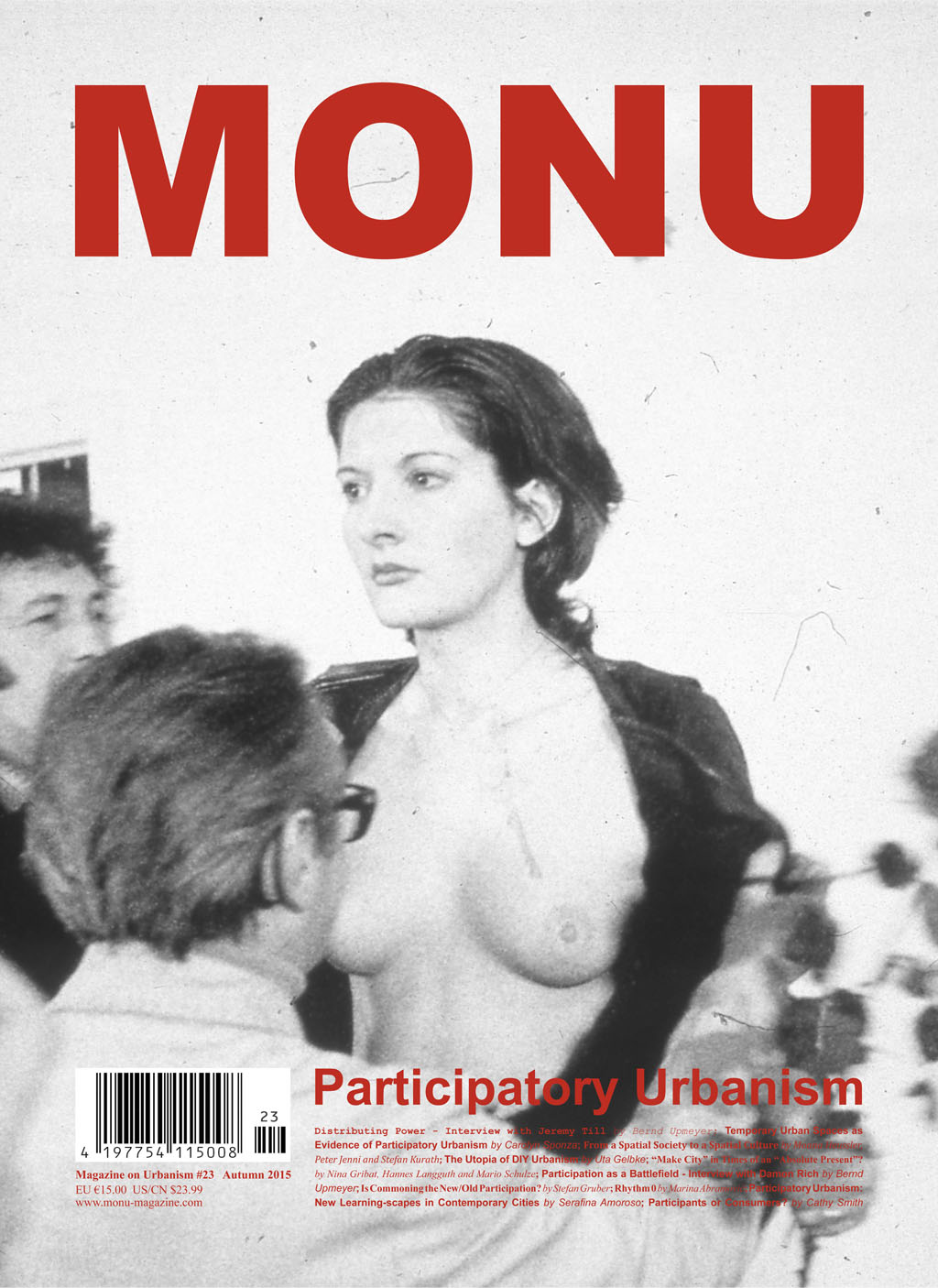
Cover of MONU #23 – Participatory Urbanism (Cover Image: Rhythm 0, performance, from
Marina Abramovic’s contribution on page 82. Location: Studio Morra Naples, 1974, Photo: Donatelli Sbarra)
They Might Kill You
By Bernd Upmeyer
While it can be easily agreed upon that design should be created for the people, it remains until now controversial to what extent design can and should be created by the people too, especially when it comes to large scale urban and architectural projects with a high level of complexity that require a lot of expert knowledge. However, as Bart Lootsma once stated in an interview that we did with him for issue #20 of my magazine MONU “the essence and charm of architecture and urbanism is that we can – and should – always keep working on them and that architecture is a cultural discipline depending on debate and not the work of engineers or scientists”.
But once people start debating design, things can easily get very complicated leading not necessarily to productive and constructive results, a process that can quickly determine the limits of participation in architectural and urban projects. When I recently initiated a MONU issue on the topic of “Participatory Urbanism”, I wanted to investigate where the limits and potential of Participatory Urbanism lie and to discover how transparent city-forming processes really can and should be before things get too difficult and become impossible to manage and function.
The weekly news magazine “The Economist”, for example, stated in one of its recent issues entitled “Space and the city” that in order to provide more housing and especially more affordable housing in cities, policymakers should ensure that planning decisions are made from the top down. Because when decisions are taken at the local level, land-use rules tend to be stricter, ultimately limiting the growth of cities and the supply of new living spaces.
With the MONU issue on Participatory Urbanism I aimed to find out whether individual citizens really can and should become proactive in the production and development of cities and the shaping of neighbourhoods. Can all participatory urban projects truly cultivate real democracy, increase civic consciousness, and boost transparency, accountability, and efficiency? To what extent has Participatory Urbanism become compromised, already ruled and co-opted by the interests of communities, local governments, organisations, neo-liberal parties, etc. rather than working for individual citizens? How can Participatory Urbanism eventually grow into a critical method of political and aesthetic urban engagement?
One of the most provocative outcomes of this MONU issue was that such participatory processes might get so intricate to become even dangerous, which was quite impressively demonstrated by Marina Abramovic in her art performance contribution “Rhythm 0”, in which she tested the limits of the relationship between performer and audience and tried to find out how far the public is willing to go, learning that: “if you leave it up to the audience, they might kill you.” Another interesting result of the issue concluded that in order to avoid participation in architecture and urban design becoming merely a politically required token of democratic involvement – a kind of fake participation that does not actually engage the participants in any meaningful way – architects, planners, and designers need to commit themselves and relinquish control, as Jeremy Till claimed in an interview with us entitled “Distributing Power”.
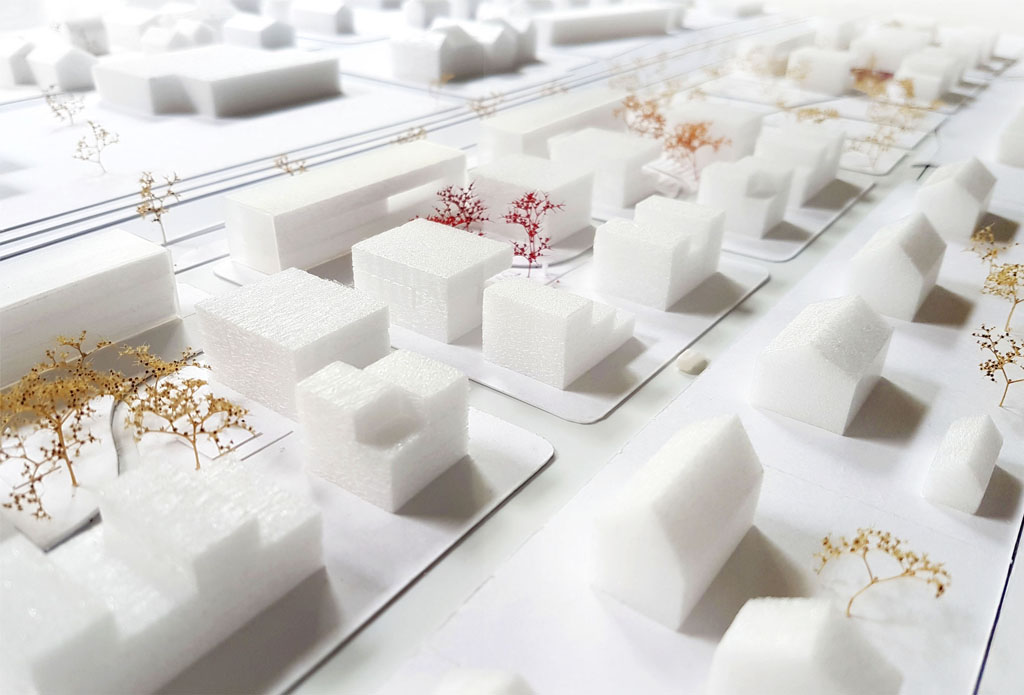
View of the new district of the Quakenbrück-project from the northwest
When I was recently involved with my office BOARD in a participatory event called “Bürgerdialog” in the German city of Quakenbrück, where we won this year the first prize in a competition for a 3 ha site to develop towards its construction, I was positively surprised that giving up control and power in such processes can indeed really work. Although the crowd that showed up at the event was fairly small, which might have encouraged the people to participate in the discussions, the people engaged productively in the debate about many details of the project that we, as the designers, will take into account during the coming months while developing it further.

Networks of Public Spaces
Especially when the public spaces and networks of public spaces of the project, that we called “Stronger than Time” and that has been described by the media as the most significant urban development project in the recent history of the city, were discussed, people were eager to contribute and proposed, for example, a new bike path from the west of the city to the site, an idea that we had already in mind from the moment we started working on the competition. Because in order to promote the connection between the old and the new town even more, and to further network the public spaces and open spaces of the city of Quakenbrück, we originally thought of such a new bike path on a former track to the west of the competition area and of a greening and improvement of the cycling and walking paths in the direction of the old centre. This would connect the Citizens Park of the new town to Quakenbrück’s main park via the new park of the competition site in the centre of the new neighbourhood, the new possible railway crossing, and the market square of the old town, from where you can continue on to one of the lakes of the city.
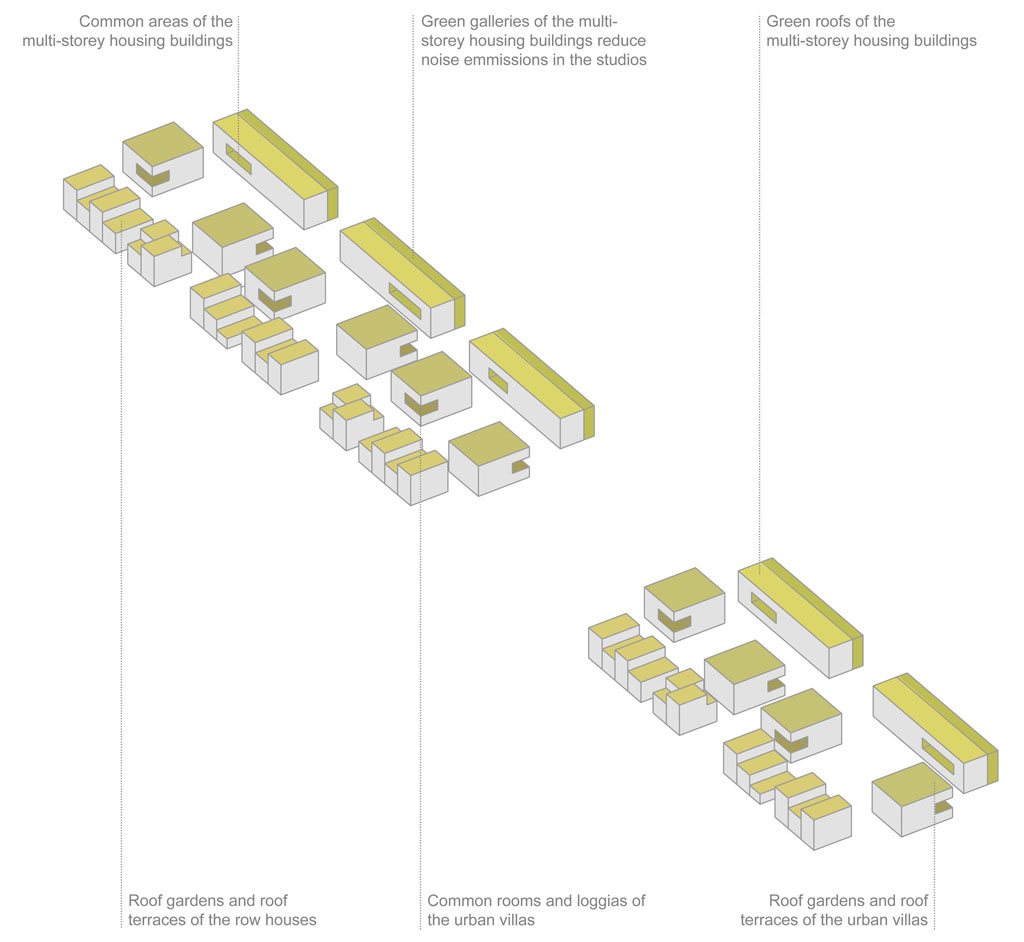
Roof Gardens, Common Areas, Loggias
Another participant supported our idea of integrating many multi-generation buildings and buildings for communal living, but also various common areas and loggias for common uses inside of the buildings, creating social cohesion throughout the new urban area. This strengthened our position towards our client, which is the city itself, convincing them that such elements are important. To create an attractive, vibrant, and sustainable residential location with a high standard of living, we proposed – apart from the common areas and loggias – a variety of rooftop gardens throughout the new urban area. Many buildings will have additional green galleries and green roofs.
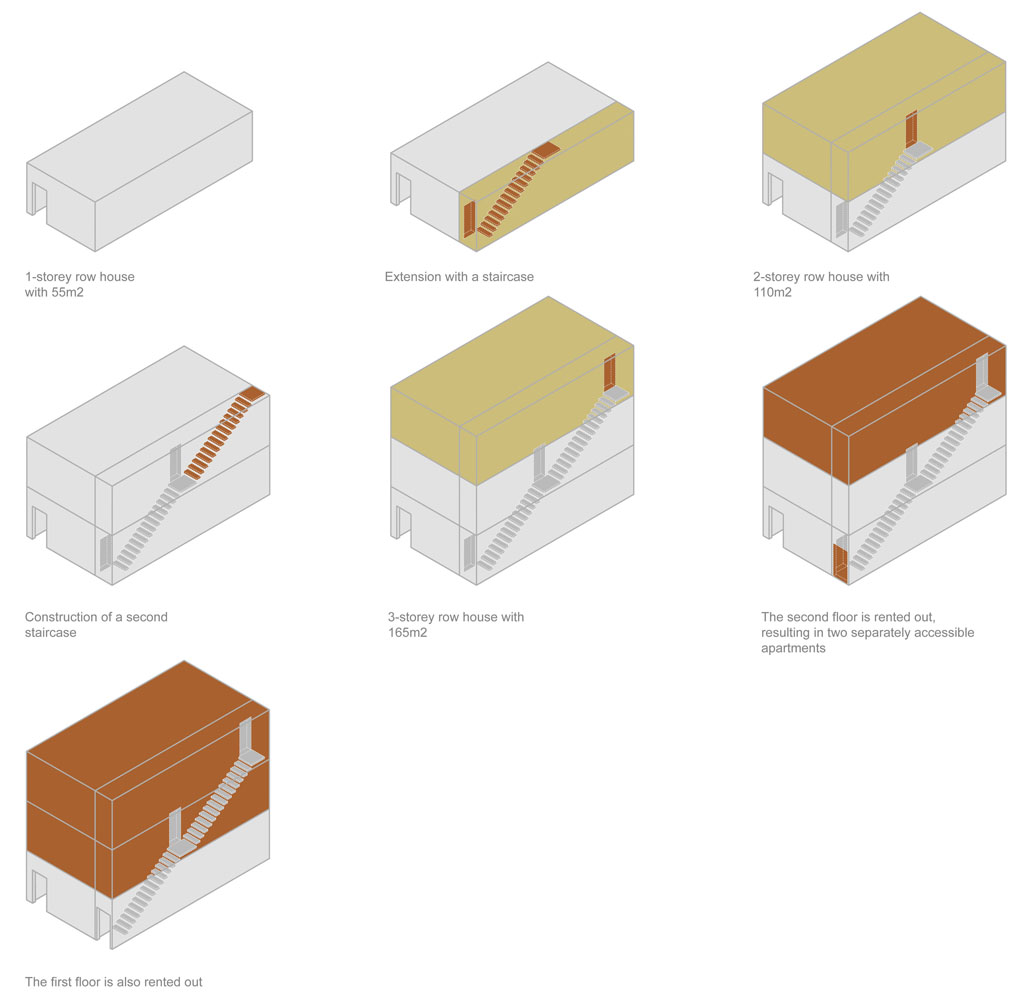
Growing and Shrinking Buildings
A third interesting remark that is worth mentioning addressed our strategy of including buildings in the master plan that can grow and shrink adapting to the changes in the life of a person or a family over time. A single woman may, for example, first move into a 1-storey row house and then later, when she founds a family, build a stairwell and build up the building first by one floor and later even by a second floor. Should the children move out at a certain moment, a separate entrance can be created and the second floor can be rented out. If the woman is single again when she is old, she can also rent out the first floor, close her door to the stairwell and return to her original home. Since the participant was wondering whether it would not be a problem to live in an area that remains constantly a construction site over quite a long period of time, we are currently developing ideas how such intrusions can be avoided.
A further proposal by one of the participants was to create out of our proposed public park in the centre of the site a multi-generation park to attract a broad range of different people of different ages to the new neighbourhood. We will take this proposal into account when working on the public park that consists mainly of two elements: a central visual axis, which represents a historical traffic axis, and a curved footpath, which makes a former track visible. Additionally, there is a playground and there are areas for picnics, sports and sculptures. The benches and small trees on the visual axis are organized in such a way that they can also be used for a market where, for example, vegetables of “urban agriculture” of the neighbourhood are offered for sale. The design of the visual axis makes it possible to create a traffic connection from a road in the west to the new district in the future. All new open spaces are barrier-free.
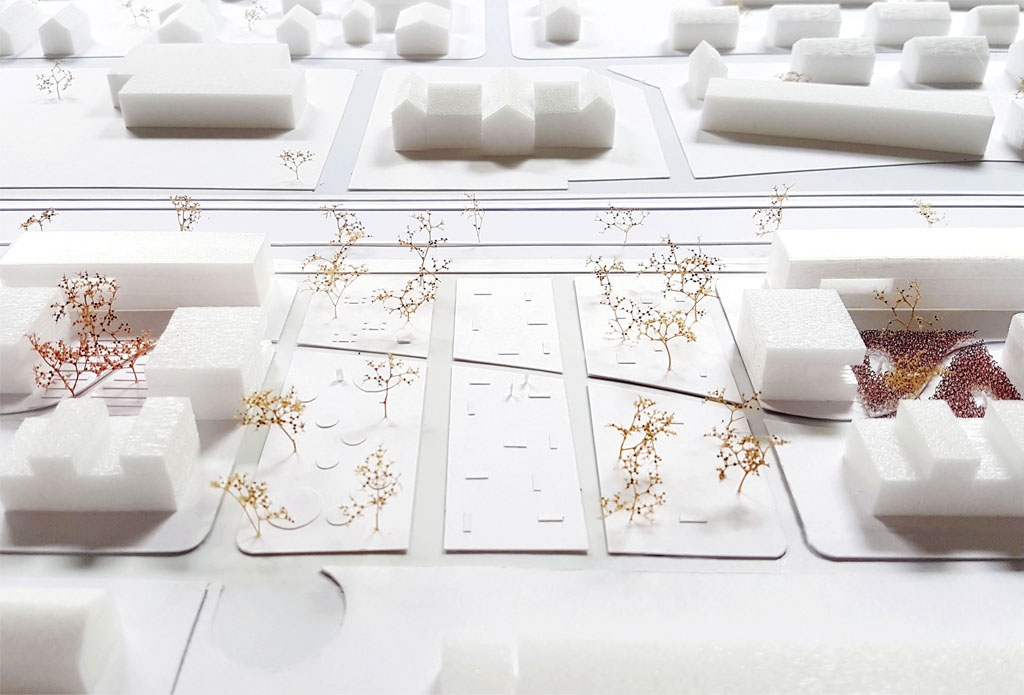
View of the new park with the station building in the background
In the end the event showed us that to organize participatory design processes in a satisfying way, architects and urban designers need the knowledge of the user as expert-citizen through which the process becomes a two-way street and expansive. Only then can public participation in architecture and urbanism lead to scenarios in which both professionals and non-professionals alike are enabled to become active producers, working inside and in between the existing spaces of their host cities.
It helped us not only to improve the project, but also to reinforce our position and our collaboration with our client that, we believe, will help us to develop a robust concept for the project site that remains adaptable over time and contributes to the convergence of the old and new parts of the city of Quakenbrück. To do so, we divided the area into 3 strips with 3 different building typologies: to the west there are innovative row houses, based on the small scale and diversity of the new town; to the east are multi-storey buildings that protect the neighbourhood against the noise pollution of the railway line; and centrally we envisage compact urban villas. This creates 5 open blocks. The fourth strip includes the existing development west of the site. A public park provides views of the historic station building.
On all 5 blocks there are private gardens for the row houses. With its trend-setting typologies, the strip of row houses offers the opportunity for an international building exhibition. The open spaces surrounding the multi-storey buildings are also private and shared by the residents of these buildings. Semi-public open spaces, green courtyards, through which a semi-public walkway connects the entire new district, are created on the middle strip of the urban villas. The main entrances of all buildings are located on the outer edge of the block. Around the block there is a public footpath and to the east a bike path.
Title: They Might Kill You
Author: Bernd Upmeyer
Date: February 2020
Type: Commissioned article
Publications: Public Design (coming soon)
Publisher: DAMDI
Location: Seoul, South Korea